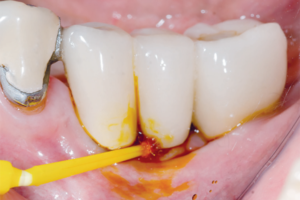AUTORES
Everton Cocati Andrade
Mestre em Clínica Odontológica Integrada – UFJF; Especialista em Prótese Dentária – ABO Muriaé; Professor – Unifagoc. Orcid: 0000-0001-9854-7685.
Evelyn Juri Rezende de Lacerda
Mestra em Implantodontia – SLMandic. Orcid: 0000-0003-3697-9567.
Larissa Martins da Costa
Mestra em Clínica Odontológica Integrada – Uniube; Especialista em Prótese Dentária – ABO Uberaba; Doutoranda Reabilitação Oral – UFU. Orcid: 0000-0002-1591-9541.
Nathan Diniz Juri Rezende
Graduando em Odontologia – Unifagoc. Orcid: 0000-0002-5234-1507.
Emir Augusto Juri de Rezende
Graduando em Odontologia – Unifagoc. Orcid: 0000-0002-2106-2396.
Karla Zancopé
Mestra e doutora em Clínicas Odontológicas, e especialista em Prótese Dentária – UFU. Orcid: 0000-0003-3697-9567.
RESUMO
Um dos principais problemas enfrentados em reabilitações protéticas com próteses do tipo protocolo é a dificuldade de higienização por parte dos pacientes. Desta maneira, o objetivo desse artigo foi descrever um procedimento clínico que aumenta o contato da base côncava de próteses totais fixas parafusadas sobre implantes com o rebordo utilizando jateamento com óxido de alumínio e uma resina composta fluida, possibilitando assim melhoras na higienização realizada pelo paciente e, consequentemente, maior chance de estabilidade na saúde dos tecidos peri-implantares.
Palavras-chave – Prótese total fixa sobre implantes; Higienização; Tecidos peri-implantares.
ABSTRACT
One of the main problems faced in oral rehabilitations with complete, implant-supported prosthesis is the difficulties of adequate homecare cleaning. In this manner, the objective of this article is to describe a clinical procedure that increases the contact of the intaglio surface for a complete fixed implant-supported prosthesis by using aluminum oxide sandblasting and flowable composite resins, thus allowing improvements in the patient self-hygiene and therefore increasing the chance for peri-implant tissue stability.
Key words – Complete fixed implant-supported prothesis; Sanitation; Peri-implant tissues.
Referências
- de Waal YC, Eijsbouts HV, Winkel EG, van Winkelhoff AJ. Microbial characteristics of peri-implantitis: a case-control study. J Periodontol 2017;88(2):209-17.
- Heitz-Mayfield LJ, Needleman I, Salvi GE, Pjetursson BE. Consensus statements and clinical recommendations for prevention and management of biologic and technical implant complications. Int J Oral Maxillofac Implants 2014;29(suppl.):346-50.
- Ebinger A, Katsoulis J, Hakimi M, Mazzi D, Mericske-Stern R. Mucosal manifestations in the edentulous maxilla with implant supported prostheses: clinical results from a well-maintained patient cohort. Clin Implant Dent Relat Res 2016;18(4):639-48.
- Behavior of implants and oral tissues in maxillary fixed prostheses, with a follow-up of 1 to 12 years: analytical cross-sectional study. Int J Oral Maxillofac Implants 2021;36(4):799-806.
- Zancopé K, Tavares LN, Soares PV, Neves FD. Estética e higiene em próteses do tipo protocolo superior – relato de caso. Prosthes Lab Sci 2017;6(23):62-6.
- Belibasakis GN, Manoil D. Microbial community-driven etiopathogenesis of peri-implantitis. J Dent Res 2021;100(1):21-8.
- Kebir M, Davarpanah M, Mattout P, Mattout C. Manutenção em Implantodontia. In: Darvapanah M. Manual de implantodontia clínica. Porto Alegre: Artmed, 2007. p.258-65.
- Bannwart IC, Dekon SFC, Pereira LV, Pellizzer EP. Higienização em prótese sobre implante. Revista odontológica de Araçatuba 2012;33(1):32-6.
- Penarrocha-Diago M, Penarrocha-Diago M, Zaragozí-Alonso R, Soto-Penaloza D. Meeting On Behalf Of The Ticare Consensus. Consensus statements and clinical recommendations on treatment indications, surgical procedures, prosthetic protocols and complications following All-On-4 standard treatment. 9th Mozo-Grau Ticare Conference in Quintanilla, Spain. J Clin Exp Dent 2017;9(5):712-5.
- Farooqui R, Aras MA, Chitre V, Rajagopal P. An in vitro study to compare the influence of two diff erent primers on the peel bond strength between a maxillofacial silicone material and an acrylic resin material versus a composite resin material. J Indian Prosthodontic Soc 2021;21(3):287-94.
- Souza IR, Pansani TN, Basso FG, Hebling J, de Souza Costa CA. Cytotoxicity of acrylic resin-based materials used to fabricate interim crowns. J Prosthet Dent 2020;124(1):122.e1-122.e9.
- Soliman HAN, Elkholany NR, Hamama HH, El-Sharkawy FM, Mahmoud SH, Comisi JC. Effect of different polishing systems on the surface roughness and gloss of novel nanohybrid resin composites. Eur J Dent 2021;15(2):259-65.
- Carneiro CA, Wassal T, Cruz F, Cruz G, Cruz M. Eficácia de um agente cimentante e antisséptico no controle bacteriano nas conexões dos implantes. ImplantNewsPerio 2016;1(3):504-10
- Carneiro CA, Wassal T, Cruz F, Cruz G, Cruz M. Efficacy of a cementing and antiseptic agent in preventing contamination and bacterial flow at the dental implant connection. ImplantNewsPerio 2016;(3):504-10.





